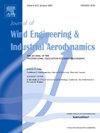A predictive large-eddy simulation framework for the analysis of wind loads on a realistic low-rise building geometry
IF 4.2
2区 工程技术
Q1 ENGINEERING, CIVIL
Journal of Wind Engineering and Industrial Aerodynamics
Pub Date : 2024-11-21
DOI:10.1016/j.jweia.2024.105950
引用次数: 0
Abstract
The accuracy of large-eddy simulations (LESs) for predicting wind-induced pressure loads remains an important topic of inquiry. This paper aims to advance this topic by validating an LES workflow for predicting wind pressures on a realistic low-rise building model exposed to a suburban neutral surface layer. We compare two wind tunnel data sets and LES predictions, obtained using a two-step workflow. First, we ensure that an accurate representation of the surface layer wind flow is obtained at the building location. Next, we assess the resulting wind loads on the building model. Using this workflow, we demonstrate consistent agreement between LES predictions and wind tunnel tests, where the discrepancies between the LES and wind tunnel results mimic the discrepancies between the two wind tunnel tests. This finding underscores that the pressure signals in certain locations are sensitive to inevitable, small differences in the approach flow. LES-based flow visualization uncovered that the most negative pressure peaks, which occur on the building roof, arise from hairpin-like vortices that are lifted from the separation region near the upstream roof edge. The results shed light on the complex dynamics of wind-induced pressure loads and contribute to quantifying the reliability of LES for wind load estimation.
用于分析现实低层建筑几何形状风荷载的预测性大涡流模拟框架
大涡流模拟(LES)预测风引起的压力负荷的准确性仍然是一个重要的研究课题。本文旨在通过验证 LES 工作流程来预测暴露在郊区中性表层的真实低层建筑模型上的风压,从而推动这一课题的研究。我们比较了两个风洞数据集和使用两步工作流程获得的 LES 预测结果。首先,我们确保在建筑物位置获得表层风流的准确表述。接下来,我们评估建筑模型上产生的风荷载。利用这一工作流程,我们证明了 LES 预测与风洞试验之间的一致性,其中 LES 和风洞试验结果之间的差异与两个风洞试验之间的差异如出一辙。这一发现突出表明,某些位置的压力信号对接近流中不可避免的微小差异非常敏感。基于 LES 的流动可视化发现,最大的负压峰值出现在建筑物屋顶上,是由上游屋顶边缘附近的分离区域产生的发夹状涡旋引起的。这些结果揭示了风引起的压力负荷的复杂动态,有助于量化 LES 用于风负荷估算的可靠性。
本文章由计算机程序翻译,如有差异,请以英文原文为准。
求助全文
约1分钟内获得全文
求助全文
来源期刊
CiteScore
8.90
自引率
22.90%
发文量
306
审稿时长
4.4 months
期刊介绍:
The objective of the journal is to provide a means for the publication and interchange of information, on an international basis, on all those aspects of wind engineering that are included in the activities of the International Association for Wind Engineering http://www.iawe.org/. These are: social and economic impact of wind effects; wind characteristics and structure, local wind environments, wind loads and structural response, diffusion, pollutant dispersion and matter transport, wind effects on building heat loss and ventilation, wind effects on transport systems, aerodynamic aspects of wind energy generation, and codification of wind effects.
Papers on these subjects describing full-scale measurements, wind-tunnel simulation studies, computational or theoretical methods are published, as well as papers dealing with the development of techniques and apparatus for wind engineering experiments.

 求助内容:
求助内容: 应助结果提醒方式:
应助结果提醒方式:


